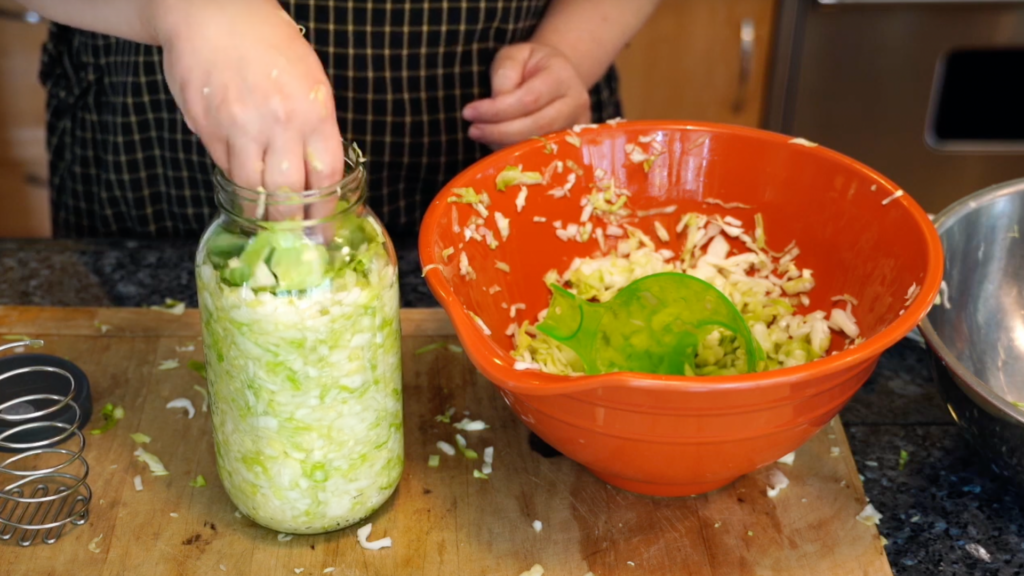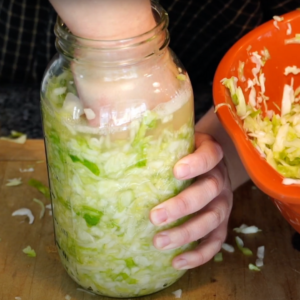This sauerkraut recipe will show you how simple homemade sauerkraut is to make. Just two ingredients and a little time will yield an exciting result. Starting this recipe right now means you’ll be eating probiotic rich wild fermented sauerkraut in a couple weeks.
Let me show you how to make how I make sauerkraut at home!

Quick Homemade Sauerkraut
The quick part of making sauerkraut is the prep, but without time sauerkraut is just a dressing free coleslaw. The magic happens during fermentation, after the juicy shredded cabbage is left at room temperature.
How do you make sauerkraut?
- Shred some fresh cabbage.
- Add the salt.
- Massage the salt into the cabbage.
- Pack the cabbage into a jar or crock.
- Make sure the cabbage is submerged under the juices.
- Weight down the cabbage.
- Cover with a breathable lid.
- Ferment at room temp for 15 – 30 days or more.
Homemade sauerkraut salt ratio
So, how do you know how much salt to use? I use an easy ratio that is on the lower end of the salty spectrum. 1 teaspoon of salt to 1 pound of cabbage.
This is a hotly debated topic among fermenters. Some say you need to do this by a percentage, typically 2% salt. Other say it’s a tablespoon per pound. I tend to lean on the less salty side, but I always taste the cabbage and I add more if I think it needs it.
I shy away from sharing percentages with new fermenters, it can be intimidating and make things seem overly complicated. You just wanted to make a condiment, not take a math class. Using the 1 teaspoon to 1 pound of cabbage makes things nice and simple. Then go ahead and adjust that to make the recipe your own!
Can you make sauerkraut without salt?
Yes, you actually can. Salt does help keep cabbage crunchy and give it an excellent flavor though, so I don’t know why you’d want to leave it out.
Homemade sauerkraut in a jar
Yes, you can make sauerkraut at home in a plain old mason jar. You don’t need a fancy crock with weights, although those are great too. If you’re just starting out with fermentation this wide mouth mason jar with the Ball Lid & Spring Set is a perfect learning set up. If you’re like me, you’ll end up loving it and using it all the time.
I use my crocks for large recipes, if I’m making a smaller batch glass jars work great. You can fit 4 – 5 pounds of cabbage into a half gallon sized mason jar.
Homemade sauerkraut crock
These beautiful Ohio Stoneware crocks are my favorite. I also have and love this airlock crock that I got on Amazon.
What to do if your homemade sauerkraut is too salty?
You can rinse your cabbage and add it back into the jar. It’s not easy and it will probably leave your sauerkraut tasting a little bland. The easiest way to avoid this is to add a small amount of salt like I do, then taste it and add more to your liking. Add it slowly, little by little, to avoid oversalting.

What to do if your homemade sauerkraut grows mold?
The best way to deal with mold is to prevent it. Mold cannot grow without oxygen. This means it will not grow under the brine. To keep your kraut safe just make sure it stays submerged under the brine.
If you do happen to find mold on the surface of your sauerkraut, you can skim it off. Wash the lid and your weight and make sure the cabbage is pushed back under the liquid. If it comes back again, you might need to toss it out. Check on your ferment often as it develops to prevent mold from growing. Skim off any floaters or foam and pack it back under the liquid. I do this daily for the first few days, but day 4 it’s usually settled in a bit and I can forget about it for a while.


How do I know when my sauerkraut is done?
The cabbage will change from a bright green to a more muted color as it ferments. The brine will become cloudy and the smell will change. The cabbage will soften, and continue to do so as it progresses. It’s your call when your sauerkraut is “done”. The only way to know is to taste it every couple of days. I like mine crunchy so I ferment it for just 18-25 days. I have also done large batches for 60 days or more.
Really, sauerkraut is “done” when the jar is empty and your belly is full.
Is sauerkraut good for you?
I’d say so! Full of probiotics, rich in vitamin C and tasty to boot! If you’re new to fermented foods, start slow and see how it makes you feel. The best person to answer the question is sauerkraut good for you? is you!
Dry salt method
The method used in this recipe is called the dry salt method. This is good for fermenting vegetables that are shredded. Salt is then massaged into the shredded vegetable, causing it to release it’s juices. The juices from the vegetables and the salt is what makes the brine. No need to add water.
The other common method for vegetables fermentation is the brine method, like when making dill pickles. You can read my recipe and tips on dill pickles using the brine method here.
Homemade sauerkraut recipe
Ingredients
- cabbage
- salt
Equipment
- Glass jar or crock
- Weight or spring
- Lid or cover
- Large bowl
- Sharp knife
- Cutting board
- Canning Funnel
- Scale




Directions
- Remove one or two outer leaves from the cabbage and set aside.
- Cut the cabbage in half and remove the core.
- Thinly slice the cabbage.
- Place in a bowl on a scale and weigh the cabbage.
- Add salt. 1 teaspoon of salt per pound of cabbage.
- Massage salt into shredded cabbage. Squeezing firmly.
- Continue to do this until the cabbage is releasing it’s juices. If it’s taking too long you can cover the bowl with a towel and let it rest for 15 minutes or so and try again.
- Pack tightly into a jar or crock.
- Top with with the reserved cabbage leaf and press down until everything is submerged.
- Add a weight or spring to hold everything down under the brine.
- Cover with a breathable lid, like the one that comes with the lid and spring set or a cloth and rubber band will do.
- Leave to ferment in a cool dark place for 15 days or much more. It’s up to you.



Notes
The sauerkraut is done when it tastes good to you. The longer it goes, the softer, darker and funkier it will get. I prefer my kraut at about 18 days. A lighter color and tangy yet crisp.
The hotter it is in your house the faster the ferment will develop.
Be sure to skim off any foam and remove any bits of cabbage from the surface of the jar so you can avoid growing mold.
Watch the full video on my YouTube channel

How to Make Simple Homemade Sauerkraut
Equipment
- Glass jar or crock
- Weight or spring
- Lid or cover
- Large bowl
- Sharp knife
- Cutting board
Ingredients
- cabbage
- salt
Instructions
- Remove one or two outer leaves from the cabbage and set aside.
- Cut the cabbage in half and remove the core.
- Thinly slice the cabbage.
- Place in a bowl on a scale and weigh the cabbage.
- Add salt. 1 teaspoon of salt per pound of cabbage.
- Massage salt into shredded cabbage. Squeezing firmly.
- Continue to do this until the cabbage is releasing it’s juices. If it’s taking too long you can cover the bowl with a towel and let it rest for 15 minutes or so and try again.
- Pack tightly into a jar or crock.
- Top with with the reserved cabbage leaf and press down until everything is submerged.
- Add a weight or spring to hold everything down under the brine.
- Cover with a breathable lid, like the one that comes with the lid and spring set or a cloth and rubber band will do.
- Leave to ferment in a cool dark place for 15 days or much more. It’s up to you.
Notes
Pin it!



Hi Hi Lanni
Thank you for the sauerkraut video. I did two nice jars with half a big cabbage. How long before it is ready and where would I store it?
Best regards
Hi! Just coming across this now. I usually ferment my sauerkraut for about 18 days, but it’s up to you. Taste as you go and see how you like it. After it’s fermented to my liking I store mine in the fridge. I hope this helps. Thanks!